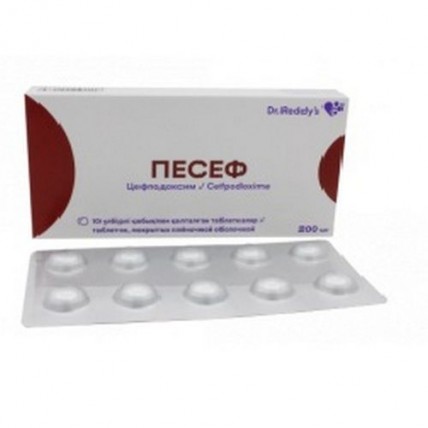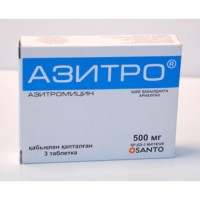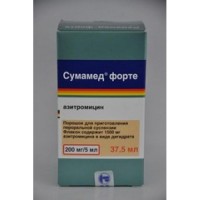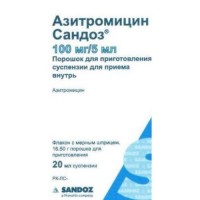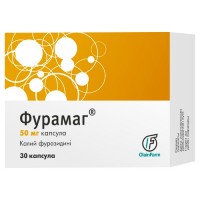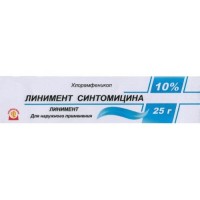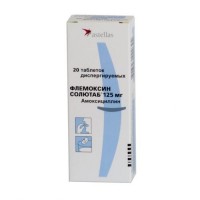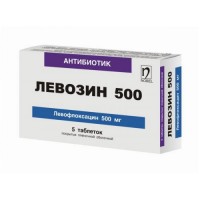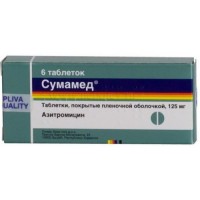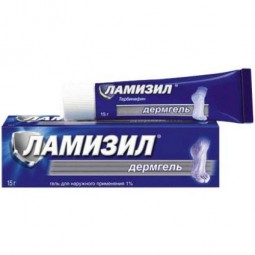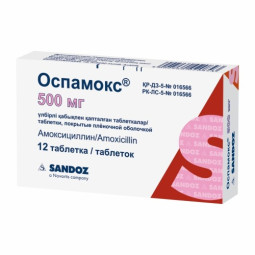Pesef 10s 200 mg film-coated tablets
- $14.30
The instruction for medical use of PESEF medicine the Trade name Pesef Mezhdunarodnoye the unlicensed name Tsefpodoksim Lekarstvennaya the Tablet form, film coated, 100 mg and 200 mg Structure One tablet contains active agent – a tsefpodoksima proksetit 130.45 mg or 260.90 mg (it is equivalent to a tsefpodoksim of 100 or 200 mg respectively) excipients: calcium carboxymethylcellulose, starch corn, krospovidon, lactoses monohydrate, sodium lauryl sulfate, hydroxypropyl cellulose. structure of a cover: the water purified opadray white IH. The description of the Tablet, film coated, round shape, from white till almost white color, with a biconvex surface and with an engraving of C1 on one party (for a dosage of 100 mg) Tablets, film coated, round shape, from white till almost white color, with a biconvex surface and with an engraving of C7 on one party (for a dosage of 200 mg) Pharmacotherapeutic group: Antibiotics for system use. A beta – laktamny antibacterial drugs other. Cephalosporins of the third generation. Tsefpodoksim. The ATX J01DD13 code proksetit the Pharmacological Tsefpodoksim's Pharmacokinetics properties – pro-medicine, is soaked up from the gastro intestinal path (GIP) and deeterifitsirutsya to an active metabolite – a tsefpodoksim. At reception of 100 mg of a tsefpodoksim proksetit on an empty stomach, about 50% of the accepted tsefpodoksim are soaked up systemically. Over the recommended dosing level (from 100 to 400 mg), it is found the dose-dependent level and extent of absorption of a tsefpodoksim. At reception of a therapeutic dose (from 100 to 400 mg), time of achievement of the maximum concentration (Tmax) is about 2-3 h and elimination half-life (T1/2) fluctuates from 2.09 to 2.84 h. The average Cmax value is about 1.4 mkg/ml at a dosage of 100 mg, 2.3 mkg/ml – at a dosage of 200 mg and 3.9 mkg/ml – at a dosage of 400 mg. At patients with normal function of kidneys each 12 h are not observed either accumulation, or significant changes in other pharmacokinetic parameters after multiple dose of a dose of drug up to 400 mg. From 22 to 33% of a tsefpodoksim contact proteins of serum and from 21 to 29% – proteins of plasma. PESEF is well distributed in bodies and fabrics. In pulmonary fabric the concentration of drug makes in 3 h - about 0.63 mkg/g, in 6 h – about 0.52 mkg/g, in 12 h – about 0.19 mkg/g that makes about 70 - 80% of concentration in blood plasma, in mucous bronchial tubes - 0.9 mkg/kg (50%), in alveolar cells – 0.1 - 0.2 mkg/kg (10%), and in pleural and inflammatory liquid collect up to 70 – 100% of concentration in blood plasma. ПЕСЕФ® gets into lungs and tissues of tonsils and maintains constant concentration of drug during 12 h at reception of a therapeutic dose and exceeds MIK90 (the minimum inhibiting concentration) for Streptococcus pyogenes, Streptococcus pneumoniae, Haemophilus influenzae. Concentration of a tsefpodoksim in pulmonary fabric in 6 - 8 h is many times higher than MIK90 for the following respiratory activators: M. (B.) catarrhalis - twice, H.influenzae and S. pneumoniae - by 20 times, S.pyogenes - approximately by 70 times. About 90% of a tsefpodoksim after reception are excreted for 12 h with urine. Use for elderly people For elderly people, including with a bronchopulmonary infection is noted small lengthening of T1/2 and concentration in blood, however not demanding dose adjustment, except for patients with the lowered function of kidneys. At elderly patients the elimination half-life of a tsefpodoksim in plasma averages 4.2 h (young patients have 3.3 h). Other pharmacokinetic parameters (Cmax, AUC (the area under a curve) and Tmax) remain invariable. Use for patients with a renal failure At patients with a reduced renal failure (with clearance of creatinine from 50 to 80 ml/min.) elimination half-life in plasma averages 3.5 h. At patients with moderated (with clearance of creatinine from 30 to 49 ml/min.) or heavy (with clearance of creatinine from 5 to 29 ml/min.) a renal failure, elimination half-life increases to 5.9 and 9.8 h, respectively. Use for patients with an abnormal liver function At patients with cirrhosis to some extent decreases absorption, and removal from an organism remains without changes. The average T1/2 value of a tsefpodoksim and renal clearance at patients with cirrhosis are also left without changes. Ascites does not influence indicators for patients with cirrhosis. This group of patients does not require dose adjustment. The pharmacodynamics of PESEF represents a semi-synthetic antibiotic of a broad spectrum of activity, a class of cephalosporins. Tsefpodoksima proksetit – pro-medicine which active metabolite is tsefpodoksy. The bactericidal activity of a tsefpodoksim consists in suppression of synthesis of a cell wall. PESEF showed activity concerning the majority of strains of the below-mentioned microorganisms: aerobic gram-positive microorganisms: - Staphylococcus aureus (including the strains produced penicillin - the storage), Staphylococcus saprophyticus - Streptococcus pneumoniae (except for the strains resistant to penicillin) - Streptococcus pyogenes - Streptococcus agalactiae - Streptococcus spp. (C, F groups, G) aerobic gram-negative microorganisms: - Escherichia coli - Klebsiella pneumoniae - Proteus mirabilis - Haemophilus influenzae (including the strains produced by β-lactamazu) - Moraxella (Branhamella) catarrhalis - Neisseria gonorrhoeae (including the strains produced penicillinase) - Citrobacter diversus - Klebsiella oxytoca - Proteus vulgaris - Providencia rettgeri - Haemophilus parainfluenzae anaerobic gram-positive microorganisms: - Peptostreptococcus magnus Tsefpodoksim is inactive concerning some strains of Pseudomonas and Enterobacter. Indications - upper respiratory tract infections, the caused Streptococcus pneumoniae, Streptococcus pyogenes, to Haemophilus influenzae or Moraxella (Branchamella) catarrhalis, including acute average otitis, sinusitis, tonsillitis and pharyngitis - the community-acquired pneumonia caused by S. pneumoniae or H. Influenzae - the exacerbation of chronic bacterial bronchitis caused by S. pneumoniae, H.Influenzae or M. Catarrhalis - the acute uncomplicated urethral or cervical gonorrhea caused by Neisseria gonorrhoeae - the acute uncomplicated anorectal infections at women caused by Neisseria gonorrhoeae - the uncomplicated infections of skin and soft tissues caused by Staphylococcus aureus or Streptococcus pyogenes - the uncomplicated infections of urinary tract (cystitis) caused by Escherichia coli, Klebsiella pneumoniae, by Proteus mirabilis or Staphylococcus saprophyticus the Route of administration and a dosage of PESEF is shown for intake at meal time. In the following table the recommended doses, treatment duration, the contingent of patients (of 12 years and is more senior), except other instructions of the doctor are provided: Adults and teenagers of 12 years are also more senior the Infection the General daily dose the dosing Mode Duration of treatment of the Upper respiratory tract infection, the caused Streptococcus pneumoniae, Streptococcus pyogenes, Haemophilus influenzae or Moraxella (Branchamella) catarrhalis, including acute average otitis, sinusitis, tonsillitis and pharyngitis Sinusitis: 400 mg Other upper respiratory tract infections: 200 mg Sinusitis: on 200 mg in each 12 h Other infections of upper dykhatel-ny ways: on 100 mg (1/2 tablets) in each 12 h 5-10 days the Community-acquired pneumonia caused by S. pneumoniae or H. Influenzae of 400 mg on 200 mg in each 12 h 14 days the Exacerbation of chronic bacterial bronchitis caused by S. pneumoniae, H.Influenzae or M. Catarrhalis of 400 mg on 200 mg in each 12 h 10 days the Acute uncomplicated urethral or cervical gonorrhoeas or anorectal infections at women caused by Neisseria gonorrhoeae of 200 mg once once Uncomplicated infections of skin and soft tissues, caused by Staphylococcus aureus or Streptococcus pyogenes of 800 mg on 400 mg in each 12 h from 7 to 14 days the Acute maxillary sinusitis caused by Haemophilus influenzae, Streptococcus pneumoniae and Moraxella catarrhalis of 400 mg on 200 mg in each 12 h 10 days the Uncomplicated infections of urinary tract (cystitis) caused by Escherichia coli, Klebsiella pneumoniae, Proteus mirabilis or Staphylococcus saprophyticus of 200 mg on 100 mg (1/2 tablets) in each 12 h 7 days For patients with normal function of kidneys and also to patients with a liver failure dose adjustment is not required. In general, differences in efficiency and safety of use for elderly and young patients are not observed. For patients with a heavy renal failure (with clearance of creatinine & lt, 30 ml/min.) the interval between receptions of doses of drug has to be increased up to 24 h. For the patients who are on a hemodialysis the frequency of dosing has to be 3 times a week after a hemodialysis. Side effects Often (more than 1%) - nausea, an abdominal pain, diarrhea - a headache - vaginal fungal infections, vulvovaginal infections Seldom (less than 1%) - dizziness, insomnia, drowsiness, concern, hallucinations, nervousness, attention disorder, confusion of consciousness, night kosh Mary, irritation of eyes, sonitus, an indisposition, fatigue, weakness - fever, a fever, generalized and local pains (stethalgias, in spin, myalgia) - migraine - gout - a cardiopalmus, stagnant heart failure, Vazodilatation - anemia - arterial hypertension or hypotension, an ischemic stroke, couple of steziya - dryness in a mouth and in a throat, thirst, a loss of appetite, distortion and loss of taste, an eructation, vomiting, an abdominal distension, dyspepsia, pain at defecation - gastritis, gastrointestinal disorders, pseudomembranous colitis - candidosis stomatitis, ulcers of an oral cavity, a disease of language, teeth. a toothache - the increased perspiration, dehydration - peripheral swell, increase in weight - dispnoe (short wind), the whistling breath, cough, bronchitis, asthma - a pleural exudate, pneumonia - nasal bleeding, rhinitis, sinusitis - allergic reactions (Quincke's edema, urticaria) - rash, including spotty, hematomas, an itching, fungal dermatitis, dryness and peeling of skin, vezikulobullyozny rash, sensitivity to UV rays, a hair loss - a hamaturia, a proteinuria, a dysuria, the speeded-up urination, a nocturia, a colpodynia, infections of urinary tract and a penis, uterine bleeding - fungal, bacterial, parasitic infections, abnormal micro biological indicators - reversible changes of laboratory indicators (short-term increase in nuclear heating plant, ALT, GGT, alkaline phosphatase, bilirubin and LDG) - an eosinophilia, a leukocytosis, a lymphocytosis, a granulocytosis, a basophilia, mono - a cytosis, a thrombocytosis, the lowered hematocrit, a leukopenia, a neutropenia, a lymphocytopenia, thrombocytopenia, positive reaction of Koombs, Uwe treatment of a prothrombin time and RTT, a hyperglycemia, a hypoglycemia, a hypoalbuminemia, a hypoproteinemia, a hyperpotassemia and a hyponatremia, increase in urea and creatinine) Contraindications - allergic reactions to a tsefpodoksim or antibiotics tsefalospori-a new row - pregnancy and the period of a lactation - intolerance of a galactose, deficiency of lactase, a glyukozo-galactose sprue - children's age up to 12 years Medicinal interactions At simultaneous use of drug PESEF with: - high doses of antacids (sodium a carbonate and aluminum hydroxide) or H2 blockers (Cimetidinum), the level of peak concentration in plasma and extent of absorption of PESEF decreases. As a result of such interaction the level of absorption does not change - anticholinergic drugs for intake, time of achievement of peak concentration in plasma (Tmax) of a tsefpodoksim is late, extent of absorption (AUC) of drug remains without change - with probenetsidy, is inhibited renal excretion of a tsefpodoksim and AUC and the Cmax level as well as with others beta laktamnymi antibiotics - the substances having nephrotoxic effect at co-administration the nephrotoxicity development is possible though when performing monotherapy by a tsefpodoksy proksetil nephrotoxicity was not noted uvelichiivatsya as a result. Cephalosporins, including a tsefpodoksim proksetit, can cause positive reaction of the test of Koombs. Special instructions before therapy by drug PESEF at patients it is necessary to conduct a careful research of presence of hypersensitivity to a tsefpodoksim, other cephalosporins, penicillin or other medicines. It is necessary to show extra care when prescribing drug to patients with hypersensitivity to penicillinic antibiotics, owing to development of cross allergic reaction between a beta - laktamny antibiotics. At emergence of allergic reaction, it is necessary to stop administration of drug. Serious hypersensitivity reactions to drug can demand therapy by epinephrine and other emergency actions, including oxygenation, intravenous administration of liquid, antihistaminic drugs, and ventilating therapy according to clinical indications. Development of pseudomembranous colitis is noted practically at all antibacterial agents, including tsefpodoksy, and differs on weight of a course: from average to a life-threatening form. Therefore it is important to consider this diagnosis at patients at whom diarrhea after intake of antibacterial drugs is observed. Use in pediatrics Safety and efficiency of use of drug for children up to 12 years is not established. Features of influence of medicine on ability to run vehicles and potentially dangerous mechanisms Considering side effects of medicine it is necessary to be careful when driving and potentially dangerous mechanisms Overdose Symptoms: nausea, vomiting, pain in epigastriums and diarrhea. Treatment: In case of development of serious toxic reaction as a result of overdose by drug, removal of a tsefpodoksim from an organism is usually carried out by means of a hemodialysis or peritoneal dialysis, especially when the renal system is subject to risk. About 23% of the accepted dose of drug are brought out of an organism during the standard 3-hour procedure of a hemodialysis the Form of release and packing On 10 tablets in blister strip packaging from printing aluminum foil. On 1 planimetric packing together with the instruction for medical use in the state and Russian languages place in a pack from cardboard. To Store storage conditions at a temperature not above 25 °C, in the dry, protected from light place. To store out of children's reach! 3 years not to apply a period of storage after an expiration date. Prescription status According to the prescription the Producer/packer of Medreich Limited, India the Holder of the registration certificate Dr. of Reddi's Laboratoris Limited, India the Address of the organization in the territory of the Republic of Kazakhstan the accepting claim (offer) from consumers on quality of medicine and responsible for post-registration observation of safety medicinal a sredstvapredstavitelstvo of the Dr. of Reddi's Laboratoris Limited company in the Republic of Kazakhstan: 050057 Almaty, 22nd Line St., 45
to Develop
to Develop
